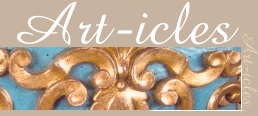      
|

Italian Mirrors: the frames (date : 15 November 2001), Mirrors held an important place in interior decoration. Beyond the aesthetic pleasure that they offered to the eye, they also made up for the shortcomings of the lighting. Except for during receptions, when candles and oil lamps were lit, light came virtually exclusively from the fireplace. Mirrors reflected and amplified the least glimmer. More than 6 categories were produced in Venice: including the architectural mirrors of the 16th century whose production lasted until the start of the following century. The pediment mirrors at the end of the 17th century whose border is in cut glass, and usually coloured blue. The silvered mirror, typical of the 18th century, is etched with acid and diamond, framed with mouldings of gilded and carved wood. At the end of the century more changes came about, gilded and carved wood was used less and less and gave way to engraved mirrors, decorated with glass thread and glass flowers. Another type of mirror, on the chimneybreast, occupied a prime position in the furnishing of the room. It remained very Italian by adopting, in preference to the French style, a tall, narrow shape, divided into three vertical panels. This type was produced around 1750. In the same way, the mirrors placed behind candleholders imitated an older construction of threaded glass and of gilded and carved wood. Another alternative was mirrors set with stoneware from Bassano, La Nove or Capo di Monte. Finally, in the 18th century, lacquered mirrors are also to be found. In Naples the use of frames in coral was preferred, sometimes along with mother-of-pearl. In the 19th century, the old styles came back into fashion, while at the same time the Egyptian campaign and the Bonapartes inspired the Empire style. It should be noted that mirror frames were not the work of cabinetmakers but were rather the preserve of the corporation of 'intagliadori' (sculptors). These used local types of wood, notably walnut, particularly abundant in Italy. Certain ornamentalists put themselves particularly to the specific task of mirror decoration: Frederic Zuccano (1536-1602) designed busts of women and garlands of fruit, Bernado Castellux (Rome around 1650) based his compositions around winged busts, cupids and also garlands of fruit. Angelo Rossi (Florence 1753) planned a chimney breast mirror of drapery, characters, armour and scrolls, while Piranese (1720-1778) designed mirrors in the neo-classical style. |
  |
|||
|
|||||